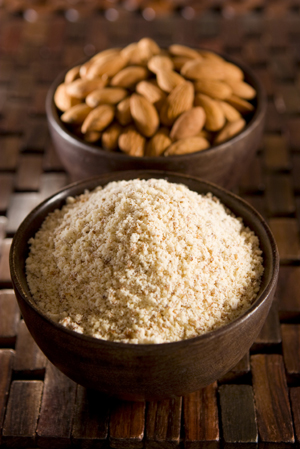Is really amazing how quickly sometimes you can change some habits (bad) with others (good)! That's what happened to me when I discovered the nuts flours! I banned white flour from our house long time ago already. You know why white flour is not good for you...right?? Really?? You don't??? Ok..ok...let's have a chatty :)
"The whiter the bread, the quicker you’re dead!" – old saying.
What does "enriched" mean? Enriched flour is flour in which most of the natural vitamins and minerals have been extracted. This is done in order to give bread a finer texture, increase shelf life and prevent bugs from eating it (bugs will die if they attempt to live off it).
Why is enriched flour bad? When the bran and the germ (the parts of the wheat that contain vitamins and minerals) are removed, your body absorbs wheat differently. Instead of being a slow, steady process through which you get steady bursts of energy, your body breaks down enriched flour too quickly, flooding the blood stream with too much sugar at once. Your body then has to work hard to absorb the excess and stores it as fat. This causes quick highs and lows in your blood-sugar level which can lead to type-two diabetes and obesity.
Here is some others interesting numbers....
Virtually all of the vitamin
Fifty percent of the calcium
Seventy percent of the phosphorus
Eighty percent of the iron
Ninety eight percent of the magnesium
Fifty to 80 percent of the B vitamins.
Flour used to be aged naturally to improve its baking quality. The milling industry now uses a gas known as chlorine oxide as an aging, bleaching, and oxidizing agent. The Environment Protection Agency warns that chlorine oxide is a dangerous irritant. Chlorine oxide interacts with some of the proteins in the flour and produces alloxan, a product of the decomposition of uric acid. Alloxan is a poison used to produce diabetes in healthy laboratory animals so that researchers can study diabetes “treatments.”
Other chemicals used on flour include nitrogen oxide, nitrosyl, and benzoyl peroxide mixed with various chemical salts.
But, how exactly is flour bleached?
Peroxides are used as bleaching agents in flour processing. In the United States, the most common flour bleaching agent is benzoyl peroxide. (Yes, the same benzoyl peroxide topically used to treat acne.) Several nations, including the European Union, Canada, and China (strange, hu?!?), have banned the use of benzoyl peroxide and other peroxides as food additives...geez..I wonder why?!?
So, now you are probably thinking, ok, I stay away from bleached flour, and go for the unbleached one, right? WRONG! Unbleached flour may still be bromated. Bromation is the addition of potassium bromate to improve flour’s baking action.
The primary concern regarding the use of bromates in baking is its demonstrated link to cancer in laboratory animals. It was first found to induce tumors in rats in 1982. However, since 1991, instead of banning bromate outright the FDA, with somewhat limited success, has merely encouraged bakers to voluntarily stop using it.
Bromates have been banned in numerous countries, including the United Kingdom in 1990 and Canada in 1994. In addition, in 1991, California declared bromate a carcinogen under the state’s Proposition 65. As such, baked goods sold in California would have to bear a store level cancer warning if they contained more than a certain level of bromate. As a result, most California bakers have switched to bromate-free processes.
I absolutely think that is very important that everybody know how bad white flour is. There are so many alternative out there, like whole wheat flour, or for who has celiac disease oat flour, coconut flour, rice flour and the nut flours, which include my favorite almond flour!
I use it all the time, baking or cooking, and I am happy, because I know that I am using good, healthy ingredients!

